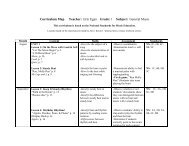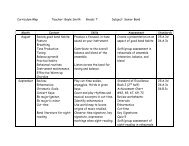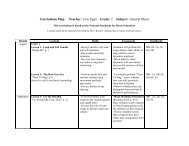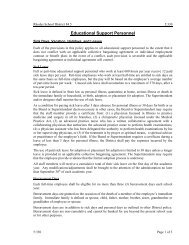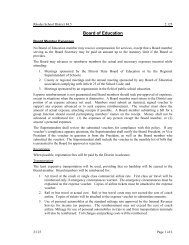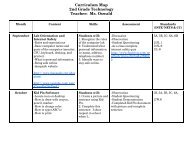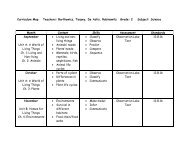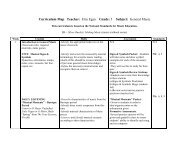You also want an ePaper? Increase the reach of your titles
YUMPU automatically turns print PDFs into web optimized ePapers that Google loves.
knowledge of<br />
note/rest values<br />
Lesson 4: Dancing in<br />
Duple Meter<br />
“Gakavik (The<br />
Partridge)” pp. 14-15<br />
“Galop” (excerpt) from<br />
Masquerade Suite<br />
(recording), listening<br />
map on p. 16<br />
-Move to show strong<br />
and weak beats in<br />
duple meter<br />
-Discuss the<br />
geography of Armenia<br />
and its musical<br />
characteristics<br />
-Ask students to<br />
demonstrate movements<br />
to show the strong beat;<br />
assess their accuracy<br />
-Play the tambourine on<br />
the strong beat and<br />
assess students’ ability<br />
to maintain the steady<br />
beat as well<br />
NS: 1A, 1C,<br />
2A, 6B<br />
October<br />
October<br />
cont.<br />
Lesson 5: I Sing, You<br />
Sing<br />
“Limbo Like Me”<br />
Brisad del Zulia<br />
(excerpt)<br />
Lesson 6: Making a<br />
Melody<br />
“Gonna Ride Up in the<br />
Chariot” p. 20<br />
“Deep in the Heart of<br />
Texas” p. 22<br />
Air in D (recording), use<br />
interactive listening map<br />
-Sing a call-andresponse<br />
song<br />
-Identify skips, steps,<br />
and repeated pitches<br />
in melodic notation<br />
-Discuss and describe<br />
the meaning of<br />
spirituals<br />
-Have students do the<br />
following: (a) Sing the<br />
responses in “Limbo<br />
Like Me,” (b) have<br />
teacher sing calls while<br />
class sings responses<br />
-Observe students’<br />
performances to assess<br />
their understanding of<br />
this form<br />
-While singing these<br />
two song selections,<br />
encourage students to<br />
point to repeated<br />
pitches, skips, and steps<br />
-Observe their accuracy<br />
while doing this task<br />
NS: 1C, 3C, 6A<br />
NS: 1C, 3C,<br />
5A, 8B, 9C<br />
Lesson 7: Pentatonic<br />
Patterns<br />
“Tsuki (The Moon)” p.<br />
25<br />
-Read a do-re-mi-solla<br />
melody from<br />
notation<br />
-Discuss Japanese<br />
styles of art and music<br />
-Learn about the<br />
pentatonic scale<br />
-Have students sing<br />
“Tsuki” with hand signs<br />
and pitch syllables, then<br />
with text<br />
-Have students sing<br />
each pattern as teacher<br />
points to it on p. 24;<br />
observe their ability to<br />
read the pentatonic scale<br />
NS: 1C, 3B,<br />
4B, 5B<br />
Lesson 9: Many<br />
Voices<br />
“I’m Gonna Sing” p. 33<br />
Ghel mama (excerpt)<br />
Sigit “Alash” (excerpt)<br />
I Don’t Want To Feel<br />
Like That (excerpt)<br />
Powwow Song (excerpt)<br />
-Identify and describe<br />
different vocal timbres<br />
-Discuss differences<br />
in culture that<br />
contribute to different<br />
vocal styles<br />
-<strong>Music</strong> Journaling: As<br />
brief examples are<br />
played, have students<br />
write a brief description<br />
that identifies and<br />
categorizes the adult<br />
singers in each example<br />
-Collect their<br />
NS: 1B, 6B,<br />
6C, 6D, 9A



